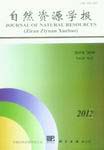Resources Evaluation
WU Wen-heng, WU Ya-jiao, LI Tong-sheng
It is significant to study the regional differentiation of rural household energy use for optimizing the energy structure, drawing up the reasonable energy use plan and protecting the eco-environment. Taking Linwei District, Guanzhong Area as a case, the differentiation features and causes of rural household energy among the plain area, loess tableland area and hilly area are studied by questionnaire and interview face to face, location quotient of energy use, and correlation analysis methods. The results and conclusions are as follows. Firstly, coal, corncob, liquid gas, honeycomb briquette, electric energy and solar energy are the comparative dominant household energy in the plain area, where the location quotient of coal reaches 2.671. Biogas, solar energy, crop straw, honeycomb briquette, liquid gas and corncob are dominant in the loess tableland area, where the location quotient of biogas comes up to 3.465. In contrast, the firewood is only prominent in the hilly area, where the location quotient of firewood is 1.142. It is more diverse for the household energy to be used in the plain area and loess tableland area than in the hilly area. But the commercial energy of successional investment such as honeycomb briquette, coal, electric energy and liquid gas are more in the plain area, while the commercial energy of non-successional investment such as biogas and solar energy are more in the loess tableland area. Comparatively, the energy structure in the hilly area is simple since firewood, the non-commercial energy, is dominant absolutely. Secondly, the regional differentiation features are that a variety of energy are coordinated each other to be utilized by the marketization guidance in the plain area, the biogas is prominent as a result of the guidance of the energy policy in the loess tableland area, and the firewood is major only due to the effect of natural conditions in the hilly area. The regional differentiation of energy use is the comprehensive results of the income level, temperature, development conditions, policy effect, and so on. Finally, per capita income of the plain area (7056 yuan) is higher than that of the others, so per capita commercial energy (204.15 kgce) is the highest in three kinds of regions; on the contrary, per capita income of the hilly area (5750 yuan) is lower than that of the others, so per capita commercial energy (45.38 kgce) is less. Per capita non-commercial energy is influenced faintly by per capita income, so the non-commercial energy use is steady relatively in the study area. Namely, whatever it is high or low for per capita income, the consumption of per capita non-commercial energy is changeless. Based on the correlation analysis it can be obtained that per capita effective cultivated land and per capita cultivated land are more, which will result in more per capita commercial energy and less per capita non-commercial energy. At the same time, the change of per capita effective cultivated land leads to the variation between the commercial and non-commercial energy more obviously than that of per capita actual cultivated land does.
